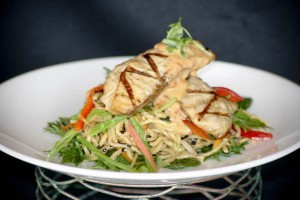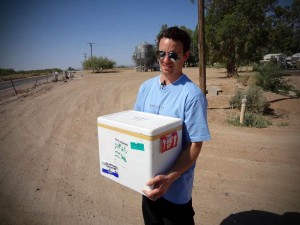Local-Food Pioneer Bon Appétit Management Company Makes Fish the New Frontier
First-ever Eat Local (Fish) Challenge spotlights seasonal seafood stars
 Palo Alto, Calif. (September 24, 2012) — On September 25, amberjack will leave its longtime wallflower role behind to become belle of the ball on Executive Chef Emanuel May’s menu at Georgia’s Savannah College of Art and Design (SCAD). That date marks the nationwide debut of Bon Appétit ManagementCompany’s first-ever Eat Local (Fish) Challenge, to be held simultaneously in all 32 states in which it operates. The event is an extension of Bon Appétit’s Eat Local Challenge, which it launched in 2005 to highlight locally harvested, seasonal flavors.
Palo Alto, Calif. (September 24, 2012) — On September 25, amberjack will leave its longtime wallflower role behind to become belle of the ball on Executive Chef Emanuel May’s menu at Georgia’s Savannah College of Art and Design (SCAD). That date marks the nationwide debut of Bon Appétit ManagementCompany’s first-ever Eat Local (Fish) Challenge, to be held simultaneously in all 32 states in which it operates. The event is an extension of Bon Appétit’s Eat Local Challenge, which it launched in 2005 to highlight locally harvested, seasonal flavors.
Growing up in coastal North Carolina, Emanuel spent countless hours reeling in regional favorites like grouper. But stocks have since declined, and he decided to give a lesser-known fish a chance. “We called amberjack ‘Reef Donkey’ – it was a stubborn challenge to a fisherman. Now it’s my new favorite,” says May. “The flavor is mild but succulent; the flesh is firm and holds up to grilling or pan searing. And serving it is a great way for SCAD students to learn about protecting the environment and supporting our local fisheries.” Seasonal supplies are plentiful, and the price is right, too, he adds.
Just as important, amberjack is both local and, if caught by hook and line, is recommended as a “Good Alternative” to eat by the Monterey Bay Aquarium’s Seafood Watch program.
The time is ripe for local fish. Eating locally and seasonally is a significant national trend, and many Americans now know the names of farms that grow their food. Still, even as we’re urged to eat more fish for its health benefits and its gustatory pleasures, few of us can identify local species or the fisherfolk who supply them. According to a new report from NOAA, in 2011 about 91 percent of seafood consumed in the U.S. was imported. These overlooked local species are important to our regional food traditions, and deserve to share the culinary limelight with heirloom vegetables, farmstead cheeses, and pastured meats.
As the first food service company to explore the nuances of local, sustainable seafood, Bon Appétit hopes to inspire consumers to expand their tastes, drive demand for these delicious fish around the country, and take the pressure off some of the sea’s most overfished species.
BACKGROUND
Bon Appétit has long made local, seasonal food, sourced from small farms in its Farm to Fork network, a mainstay of its menus. For the first Eat Local Challenge, in September 2005, its chefs pulled out all the stops to cook a regionally authentic meal made entirely of ingredients harvested within 150 miles, with salt the one exception permitted. This year, local seafood — caught or farmed within 500 miles — must also be one of the ingredients. Just as local peaches in lieu of far-away pineapple were a revelation to diners in 2005, Bon Appétit hopes these rediscovered flavors will prompt diners to swim outside the usual air-freighted, mass-caught, or industrially farmed catch.
 Some of the Challenge’s stars have been found swimming in unexpected places. In the middle of Arizona’s Sonoran Desert, one of the country’s hottest and driest spots, Bon Appétit Executive Chef Edward Farrow discovered sustainably farmed tilapia. Located 128 miles from Phoenix, Desert Springs Tilapia farm uses recirculated well water in a closed-loop ecosystem.
Some of the Challenge’s stars have been found swimming in unexpected places. In the middle of Arizona’s Sonoran Desert, one of the country’s hottest and driest spots, Bon Appétit Executive Chef Edward Farrow discovered sustainably farmed tilapia. Located 128 miles from Phoenix, Desert Springs Tilapia farm uses recirculated well water in a closed-loop ecosystem.
A deep dive into fish wrangling isn’t new for Bon Appétit. A backer of the Monterey Bay Aquarium’s Seafood Watch sustainable seafood program since 2002, the company launched its groundbreaking Fish to Fork preferred purchasing program in September 2011 as a companion to its longtime Farm to Fork program. Fish to Fork’s guidelines for supporting local, small-scale, environmentally responsible fishing and aquaculture include requirements for traceability, size of boat or aquaculture operation, distance-at-sea limits for wild fish, and distance from the dock or farm distribution radius from Bon Appétit kitchens.
As part of Fish to Fork, 14 Bon Appétit chefs were appointed “piscators” — fish foragers charged with casting out nets in their regions for new fish to feature. Top of their target lists: low-on-the-food-web species such as sardines and oysters, and less-well-known larger species such as farmed sturgeon.
IS THERE A CATCH?
“Local” doesn’t always equal sustainable, however, which is where Seafood Watch comes in. Conscientious consumers depend on the science-based red (Avoid), yellow (Good Alternative), and green (Best Choice) recommendations of itswallet cards and smartphone apps. For Bon Appétit, this year marks a decade of meeting Seafood Watch’s guidelines for corporate buyers, and it had no intention of serving anything listed as “Avoid” for Eat Local (Fish) Challenge Day.
However, some local wild fish — like hogfish in Florida and jolthead in North Carolina — come from fisheries too small to have been assessed by Seafood Watch. What to do?
Helene York, director of purchasing strategy and captain of the Fish to Fork program, approached the Seafood Watch scientists with an idea. Bon Appétit piscators could collect and share data on where the fish was harvested and by what methods, seasonality, catch method, and boat size in accordance with Seafood Watch’s science-based criteria. York — named a Seafood Champion by SeaWeb in 2010 — would conduct a preliminary screening as to whether the fish might make the “yellow” or “green” cut. They would become the first entries in Seafood Watch’s pilot of an external assessment model, in which third parties such as Bon Appétit can engage external scientists trained by the Seafood Watch program to formally assess fisheries and aquaculture operations of interest. The end goal: an official Seafood Watch recommendation for more local fish.
“We know that locavores care about where their food comes from. By allowing sustainable seafood advocates such as Bon Appétit Management Company to work with a pool of scientists who adhere to our rigorous research protocols, we hope to identify even more ocean-friendly, locally sourced seafood,” says Jennifer Dianto Kemmerly, director of Seafood Watch. “We’re pleased to kick off this effort as part of the Eat Local (Fish) Challenge. Bon Appétit’s commitment to sustainable seafood sourcing remains second to none.”
On Eat Local (Fish) Challenge Day, Chef Emanuel will serve seared amberjack with a sauce made from peaches and Thai chiles, for a locally grown, Southern-Asian fusion dish at SCAD’s main café, the Hive. Meanwhile, Chef Edward will grill his desert tilapia, set it on a bed of sweet potato puree and okra roasted with honey, and serve it with a salad of local arugula, radishes, and tomatoes for a 100% local meal sure to amaze guests at Phoenix’s Musical Instrument Museum.
“As a company, we have always believed that if you lead with flavor, sustainability will follow,” says York. “Sourcing the freshest local ingredients not only pays culinary dividends, it directly supports a community’s producers — whether farmers, fishermen, or fish farmers. It makes no sense to fly in fresh fish trawled from Asia when you can get halibut caught sustainably by someone whose tax dollars keep your town running.”
Captions, top: Passmore Ranch sturgeon, sustainably farmed near Sacramento, CA, will appear on many Bon Appétit Bay Area menus Tuesday. Middle: Chris Lenza, Bon Appétit Management Company “piscator” and sous chef at the Musical Instrument Museum in Arizona, cradles a desert-raised tilapia. High-resolution versions available.
About Bon Appétit Management Company
Bon Appétit Management Company (www.bamco.com) is an on-site restaurant company offering full food-service management to corporations, universities, and specialty venues. Based in Palo Alto, CA, Bon Appétit has more than 500 cafés in 32 states, including eBay, the University of Pennsylvania, and the Getty Center. All Bon Appétit food is cooked from scratch, including sauces, stocks, and soups. A pioneer in environmentally sound sourcing policies, Bon Appétit has developed programs addressing local purchasing, the overuse of antibiotics, sustainable seafood, the food and climate change connection, humanely raised meat and eggs, and farmworker welfare. It has received numerous awards for its work, from organizations including the International Association of Culinary Professionals, the James Beard Foundation, Chefs Collaborative, Natural Resources Defense Council, Seafood Choices Alliance, The Humane Society of the United States, and Food Alliance.
About Monterey Bay Aquarium Seafood Watch
The mission of the nonprofit Monterey Bay Aquarium is to inspire conservation of the oceans. The aquarium’s Seafood Watch program empowers seafood consumers and businesses to make choices for healthy oceans. In doing so, the program works to transform seafood markets in ways that create incentives for sustainable fishing and aquaculture practices. www.seafoodwatch.org
Contacts:
Haven Bourque, [email protected], (415) 505-3473
Bonnie Powell, [email protected], (650) 621-0871